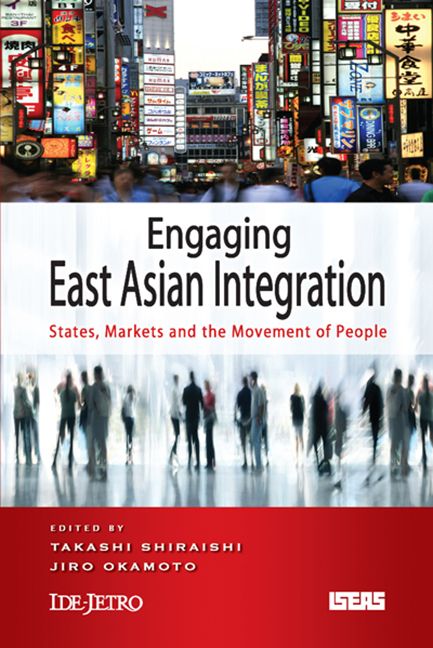Book contents
- Frontmatter
- Contents
- Foreword
- List of Figures and Tables
- Contributors
- 1 Introduction
- Part I EVOLUTION OF EAST ASIAN INTEGRATION
- 2 Japan and East Asia in the American Imperium
- 3 Building a Neighbourhood — One Policy at a Time: The Case for Deeper Economic Integration in East Asia
- Part II STATES, MARKETS AND THE MOVEMENT OF PEOPLE
- Index
3 - Building a Neighbourhood — One Policy at a Time: The Case for Deeper Economic Integration in East Asia
from Part I - EVOLUTION OF EAST ASIAN INTEGRATION
Published online by Cambridge University Press: 21 October 2015
- Frontmatter
- Contents
- Foreword
- List of Figures and Tables
- Contributors
- 1 Introduction
- Part I EVOLUTION OF EAST ASIAN INTEGRATION
- 2 Japan and East Asia in the American Imperium
- 3 Building a Neighbourhood — One Policy at a Time: The Case for Deeper Economic Integration in East Asia
- Part II STATES, MARKETS AND THE MOVEMENT OF PEOPLE
- Index
Summary
INSIGHTS ON THE BENEFITS OF EAST ASIAN INTEGRATION
The benefits of regional integration are greater than previously realized. This section summarizes the main benefits of regional integration as documented in the literature on this, and discusses recent work that suggests that regional integration can be even more beneficial than previously realized, especially if the potential associated risks of integration are managed properly.
The Benefits of Regional Integration
Conventional Analysis Stresses Specialization as the Driver of Benefits
The conventional analysis of the benefits of regional integration focuses on trade in goods and emphasizes trade and location effects. The preferential reduction in tariffs through regional agreements induces a shift in demand towards exports from partner countries at the expense of domestic production (trade creation) and away from exports from non-member countries (trade diversion). According to this view, trade creation improves welfare, trade diversion reduces it. Changes in trade flows induce changes in the location of production between member countries of a regional agreement based on static comparative advantage (specialization).
New Insights Identify Economies of Scale and Agglomeration Economies as the Key Driver
The new economic literature — sometimes called the “new international trade theory” — summarized in An East Asian Renaissance (Gill and Kharas 2007) and World Development Report (World Bank 2009), emphasizes the increasing role of economies of scale and agglomerations economies as central forces driving international trade, the geographical concentration of economic activity, and economic growth. While this theory was developed in the late 1970s (Krugman 1979), empirical support has been more recent. The premise of the new thinking is that when trade barriers fall, firms gain access to bigger markets, allowing them to expand production and reap economies of scale. But openness also exposes them to competition from rival foreign firms, paring their margins. As such, some firms may go out of business, but between the domestic survivors and the foreign entrants, consumers will have more variety of goods to choose from. Thus the main gains from trade arise not from specialization, but from economies of scale, fiercer competition, and increased consumer choice that regional integration and, eventually, globalization provide.
- Type
- Chapter
- Information
- Engaging East Asian IntegrationStates, Markets and the Movement of People, pp. 46 - 94Publisher: ISEAS–Yusof Ishak InstitutePrint publication year: 2012



